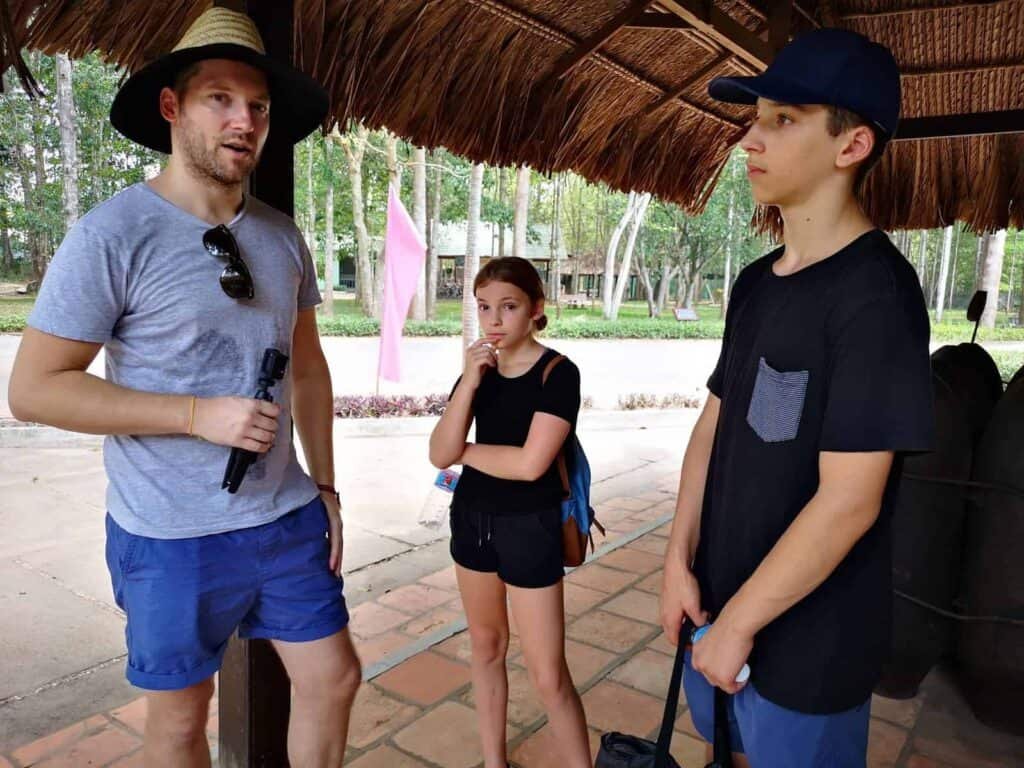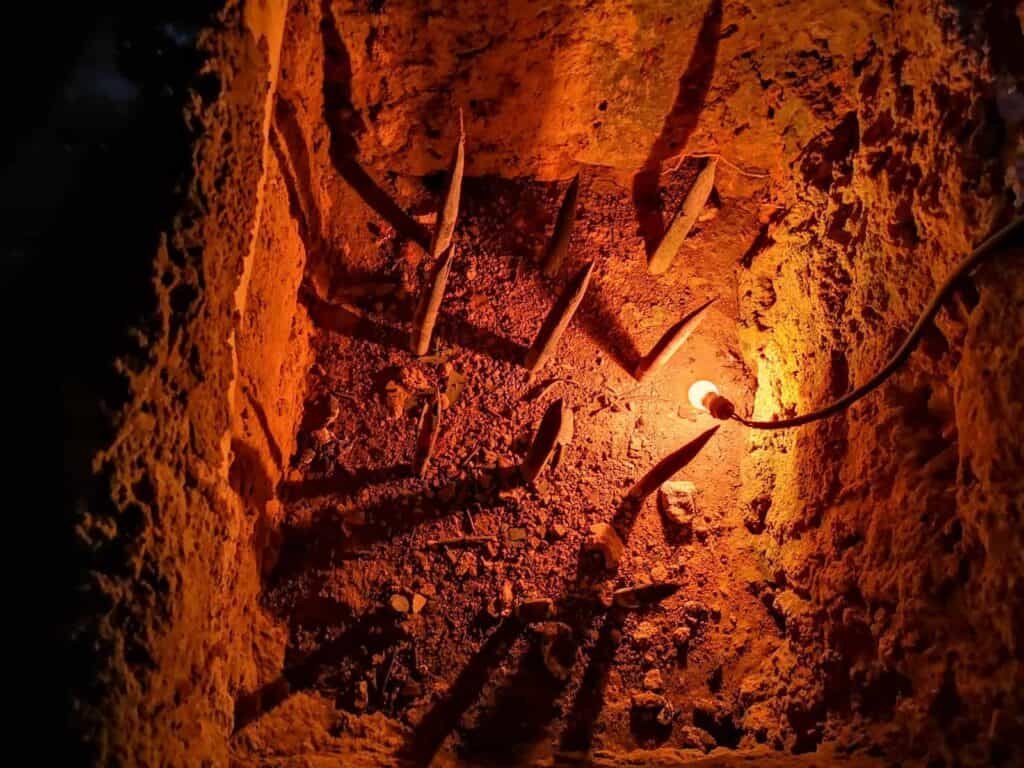The Cu Chi Tunnels are a must while visiting Ho Chi Minh City, in Vietnam.
There are many options for Cu Chi Tunnel tours, depending on your budget and preference.
If you are staying in District 1, like most tourists, you can take your pick from any one of the multitudes of companies offering to take you on a tour bus for a half or a full-day tour of the Cu Chi Tunnels.
These tours often pick you up early in the morning and head to the principal, larger Cu Chi Tunnels site at Ben Dinh, usually with a stop off at a lacquer factory as part of the tour.
Depending on how much you pay, it may include lunch.
If, like us, you tend to prefer to do it yourself and want to organize your own Cu Chi Tunnel day tour, we’ll show you how.
Contents
Cu Chi Tunnels History
The Cu Chi Tunnels helped the communist forces to win the war by providing the Viet Cong protection from the Americans, Australians, and the South Vietnamese.
It was where the Viet Cong planned the Tet Offensive and ran many of their military operations.
These tunnels are part of an extensive network throughout the country and allowed the Viet Cong to hide underground during the day and rise up at night to fight the enemy, guerilla-style.
Their enemy tried several times to destroy the tunnels, but it wasn’t until 1969 that the B-52’s started carpet bombing the area that they had any real impact on eradicating the tunnels.
Despite the bombing, the tunnels remained crucial in the efforts of the communist forces.
Need to know what to do in Ho Chi Minh City? Check out our post!

How to Get to the Cu Chi Tunnels
There are several different ways of getting to the Tunnels.
Your options include taxi, boat, tour bus, motorbike, bicycle, and public transport.
The public transport system does take a little longer than the rest, so you need to set aside time for the Cu Chi tunnels as a full-day tour.
If you are low on time, it might be a good idea to do a half-day Cu Chi Tunnels tour from Saigon with a tour operator.

Bus 13 From Ho Chi Minh City
Head toward the bus station in District 1. The exact address in Google Maps is TĐH xe buýt Sài Gòn, Phạm Ngũ Lão, District 1, Ho Chi Minh City.
At the park’s end, the bus station is between the two main roads and reasonably close to Walking St.
Buy your tickets on the bus – there’s no need to try and buy them at the ticket office. They are 10,000 dong each.
We got to the bus station at 8 am and the bus left at 8:15 am. We arrived at the Cu Chi Bus station 1 hour and 35 minutes later.



Bus 79 From Cu Chi Bus Station
Once you get to Cu Chi Bus Station you will need to change buses, and get on Bus 79, which will take you to the Ben Duoc Tunnels.
As you get off the No. 13 bus you’ll be accosted by taxi drivers wanting to take you to the tunnels. Politely ignore them and head toward bus 79.
The Bus to Cu Chi Tunnels will cost another 6000 dong, and it took us a further 45 minutes to get there. I don’t think you need to worry about when to get off, as the ticket person will simply assume you’re heading to the tunnels, and tell you when it’s time.
Just for reference, I have marked both stops on the maps below.


Cu Chi Tunnels – Ben Duoc
These are the smaller less frequented tunnels, as they are further away from Ho Chi Minh City.
The Wikipedia article on the sites says that the tunnels at Ben Dinh were made larger for the tourists to fit through.
I think it’s worthwhile spending longer on the bus to experience the more authentic tunnels, with fewer fellow tourists around.
When you arrive I would suggest that you buy some water from the corner store before entering, unless you are okay with paying exorbitant prices for a small bottle of water once inside!


The opening hours for both sites are from 8 am to 5 pm every day, but the prices are different.
Ben Duoc Cu Chi Tunnels entrance fee is 90,000 dong, this covers both the entry and the mandatory tour guide. The Ben Dinh entrance fee is 110,000 dong.
At Ben Duoc, when you enter through the gates walk along the road and follow it around to the left.
You will then see a ticket booth where you buy your tickets before following the road up towards the temple.
Once at the temple, don’t hang around too long as the tour guides wait for a group just big enough before starting the tour, and you don’t want to miss anything.
Follow the path toward the start of the site of the tunnels.

The Start of the Cu Chi Tunnels Tour
Before the guide takes you on the tour of the tunnels, take the time to look at the war relics on display including rusted out tanks, a B-52, a Huey helicopter, different types of guns, and bomb and rocket remnants.
We also made sure to explain the basics of the Vietnam war to the kids, and how the Cu Chi Tunnels played a part in the victory for the North Vietnamese over the South.


It’s mandatory to follow a guide for the tunnels tour. They will wait until there are enough people in the group before they head off on the tour, and will lead you through the jungle towards an area where you can watch a video about the war and the tunnels, and afterward, will answer any questions.
There is also a map/diagram of the Cu Chi Tunnels, as well as an example of what the tunnels looked like underground.
From there the guide will take you on a walk and show you examples of tunnels, and what is in them.
You can, if you like, crawl through some of them. Please note, that these ones are not very big, and from what I understand the tunnels at Ben Duoc have not been widened for tourists.
We are both about 6ft tall, and I felt I almost had to crawl on my hand and knees at some points.
The entrance to these tunnels, however, has been altered to make it easier for tourists to enter them. In the war, all entrances were hidden from view so the enemy could not find them.
The first tunnel we went through, some people turned right instead of left, and part of our group got stuck down there for almost 10 minutes! If you get lost, just stay calm, and retrace your steps.



This amazing network of tunnels allowed the Viet Cong to travel unnoticed by the enemy.
The tunnels had an impressive ventilation system, hospitals, kitchens, trenches, and bunkers.
They were protected by booby traps, so if the enemy did find the tunnels, their attempts to infiltrate might be foiled!


Cu Chi Tunnels Traps
At the end of the tour were more examples of the different types of traps used in the Cu Chi Tunnels, some of them more gruesome than others.
The inevitable gift shop is located toward the exit, and there is a gun range where you can shoot a variety of guns including an AK 47, M16, M30, and more.





